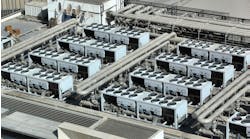Schneider Electric and PG&E announce DER management system on Microsoft Azure for grid reliability
Reliable energy service is both more challenging and essential than ever as the country experiences extreme weather events and heavier demand for electricity. Distributed energy resources (DER) have grown significantly to provide much-needed load flexibility as more renewables come online, while distributed energy resources management systems (DERMS) help harness it when and where it’s needed.
A new DERMS solution from Schneider Electric and Pacific Gas and Electric Company (PG&E) recently announced on Microsoft Azure promises to effectively maintain grid reliability and accelerate customer adoption of distributed energy resources (DER) such as electric vehicles (EVs), energy storage, and rooftop solar within smart buildings. EcoStruxure DERMS provides “greater visibility into DER behavior and the ability to control DER intelligently. Greater situational awareness allows for more proactive management to keep the grid safe, secure and resilient, while helping utilities provide clean, reliable and affordable energy to their customers,” according to a press release.
Patti Poppe, chief executive officer for PG&E Corporation commented:
“Having efficient and reliable renewable energy resources integrated into the grid, with a powerful DERMS controlling and synchronizing them means that we can continue to grow the share of renewables in the grid while maintaining safe and reliable power. It’s a customer-focused energy solution that will bolster reliability and affordability on the path to a clean energy future.”
EcoStruxure DERMS’ advanced management of DER directly supports PG&E’s plans for meeting and exceeding California’s climate and clean energy goals, while supporting an affordable transition to a highly electrified, renewable grid. Serving more than 16 million people across Northern and Central California, PG&E is taking proactive measures to ensure grid reliability and meet the growing electricity demands of California—and DERMs will enable the dispatch of these technologies when the state needs energy most.
Priority Use Cases
Schneider Electric’s DERMS strategy offers a variety of capabilities, and together with Microsoft and PG&E, the companies have identified several foundation use cases for the new system, including:
- Real-time visibility into all DER. Enhanced situational awareness of grid impacts, both in real-time and with forecasted lookahead, plus instant alerts for improved operations planning.
- System capacity for peak summer days. Visualized DER capacity, timely impact analysis, customer feedback (measurement and verification), and additional DER capacity.
- Local capacity for new service connections and interconnections. Oversight of interconnection requests enables utilities to leverage actionable data to faster evaluate and process DER connection requests and streamline processes that ensure resilience.
- Reliability and resilience with energy storage. Utility-owned & aggregator-provided storage asset dispatch for improving local reliability and network deferral (non-wire alternatives).
- Transportation electrification. Integration, managed charging and vehicle-to-grid coordination for residential vehicles and commercial fleets.
They are continuing to build and enhance the platform to address additional use cases over the next several years.
For more news, projects, and profiles in the smart buildings ecosystem, subscribe to the SBT newsletter and follow us on LinkedIn, X, and Facebook.


